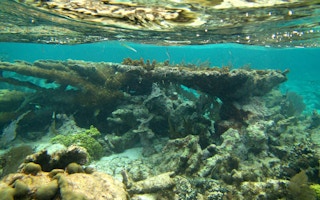As rising sea surface temperatures drive more frequent and more intense coral bleaching episodes around the world, global models have often predicted that few healthy coral reefs will remain in tropical oceans a century from now.
Field work has shown that there is considerably more variability in how corals respond to temperature stress across different geographic regions than the models predict, however.
According to the authors of a study published in the journal Nature Communications last week, “This mismatch between global models and field results underscores the urgent need to develop better models that accurately predict the geographical heterogeneity of coral bleaching as corals respond to ocean warming.”
Also highlighting the need for models that more accurately predict reef systems’ responses to warming waters: The authors’ own study found that coral reefs at or near Earth’s equator are actually impacted less by ocean warming than other corals.
Lead author Shannon Sully, a Ph.D. student at Florida Institute of Technology, led a research team that used field observations collected over the course of two decades to analyze coral bleaching patterns.
The global coral survey that informed the study included more than 3,300 study sites in 81 countries and was performed by US-based NGO Reef Check between 1998 and 2017.
Sully and team’s results show that coral bleaching was most common in areas that experienced anomalously high water temperatures most frequently. But they also showed that coral bleaching was much less common in areas with high variability in sea surface temperatures.
“Significantly more coral bleaching occurred at mid-tropical latitude sites, between 15 and 20° north and south of the Equator, than in the equatorial regions, where coral diversity is highest,” Sully and co-authors write in the study.
The fact that coral bleaching was more common at 15 to 20 degrees north and south of the equator was not a result of higher water temperatures at those latitudes, however.
“We found that the reefs near the Equator were less affected by bleaching than elsewhere, despite similar thermal-stress levels at equatorial sites,” study co-author Deron Burkepile of the University of California, Santa Barbara, said in a statement.
“
We are uncertain why equatorial reefs are more tolerant of recent temperature stress, but we do know that we must protect these equatorial reefs.
Rob van Woesik, director, nstitute for Global Ecology, Florida Institute of Technology
Previous studies of the region have concluded that there is less bleaching in equatorial areas with high coral diversity, but Sully and team did not find this to be the case — the equatorial sites that they studied are some of the most diverse in the world.
The researchers have three hypotheses that explain these discrepancies: they could be due to different species composition in reef systems in different areas; higher coral diversity at low latitudes, which means that there could be coral types that are less susceptible to thermal stress; or the corals at lower latitudes are “preadapted to thermal stress” because they are subjected to consistently warmer water temperatures.
“These hypotheses are not mutually exclusive and several of these mechanisms could be operating in concert, resulting in less coral bleaching at low latitudes,” the researchers write.
Previous regional studies also determined that a small daily temperature range was the best metric for predicting bleaching episodes. Sully and team’s findings support this conclusion: “Our results suggest that localities that commonly experience large daily, weekly, or seasonal [sea surface temperature] ranges may harbor corals, and strains of coral symbionts, that are more resistant to [sea surface temperature] extremes.”
The team calls for further research to examine “to what extent acclimation versus adaptation is contributing to reduced coral bleaching prevalence.”
Another key finding: Over the last decade, coral bleaching has occurred at temperatures about 0.5 ° Celsius higher than in the previous decade. “At the thousands of sites surveyed, the mean [sea surface temperature] recorded during coral bleaching in the first decade of the dataset, from 1998 to 2006, was 28.1 °C, whereas the mean [sea surface temperature] recorded during coral bleaching in the second decade, from 2007 to 2017, was 28.7 °C.”
This suggests that past bleaching events have already culled the coral that are “thermally susceptible,” and the remaining coral populations are able to withstand higher temperatures without bleaching.
Again, more research is needed in order to understand the implications of this finding, the authors write: “Coral communities also may have acclimatised to increasing [sea surface temperatures], highlighting the need for further research to understand the context dependencies of this trend towards a greater temperature threshold.”
Immediate action to reduce carbon emissions is necessary worldwide if we’re to avoid further declines of coral reefs, study co-author Rob van Woesik, a professor and director of the Institute for Global Ecology at Florida Institute of Technology, said in a statement.
“We are uncertain why equatorial reefs are more tolerant of recent temperature stress, but we do know that we must protect these equatorial reefs — and reefs everywhere — from other disturbances, lest we lose coral reefs that protect coastal inhabitants from storm waves and help feed millions of people worldwide.”
This story was published with permission from Mongabay.com.










